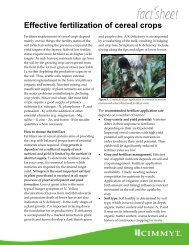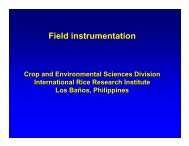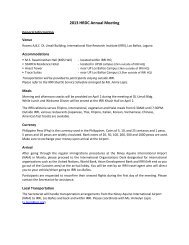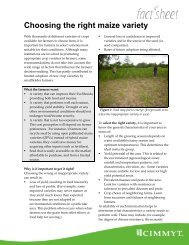The plant-soil-water system22.1 <strong>Water</strong> movement <strong>in</strong> the soil-plantatmospherecont<strong>in</strong>uum<strong>Rice</strong> plants take up water from the soil and transportit upward through the roots and stems and releaseit through the leaves and stems as vapor <strong>in</strong> the atmosphere(called transpiration). The movement ofwater through the plant is driven by differences <strong>in</strong>water potential: water flows from a high potentialto a low potential (imag<strong>in</strong>e free water flow over aslop<strong>in</strong>g surface: water flows from the top, with ahigh potential, to the bottom, with a low potential).Different units express water potential (Table 2.1)and, unfortunately, different authors report differentunits. In this report, we usually use the termPascal (P).In the soil-plant-atmosphere cont<strong>in</strong>uum, thewater flows from the soil, with a relatively highpotential, through the plant to the atmosphere justoutside the leaves, which has a relatively low potential.Potentials <strong>in</strong> the soil-plant-atmosphere areusually negative and we also use the term “tension,”which has the opposite value. For example, a tensionof +10 kPa is the equivalent of a potential of–10 kPa. The term tension is <strong>in</strong>tuitively easier tounderstand: a high tension suggests a high “pull<strong>in</strong>gforce.” Thus, water flows from a low tension <strong>in</strong>the soil (low pull<strong>in</strong>g force) to a high tension <strong>in</strong> theatmosphere (high pull<strong>in</strong>g force). The water tension<strong>in</strong> the atmosphere outside the leaves is determ<strong>in</strong>edby climatic factors: relative humidity, w<strong>in</strong>d speed,temperature, and solar radiation. This atmospherictension translates <strong>in</strong>to the “evaporative demand”of the atmosphere, which determ<strong>in</strong>es potentialtranspiration rates. The water tension <strong>in</strong> the soilis determ<strong>in</strong>ed by the amount of water <strong>in</strong> the soiland by soil physical properties such as texture andbulk density. The speed with which water movesthrough the plant is determ<strong>in</strong>ed by the difference <strong>in</strong>water tension between the soil and the atmosphere(the higher the differences, the faster the water willflow) and by the resistance to water flow <strong>in</strong> the plant(Ehlers and Goss 2003). First, soil water needs toovercome a physical resistance (the epidermis)to enter the roots. Then it flows through cells orthrough spaces between cells <strong>in</strong>to so-called xylemor vascular bundles that will transport it upward.The water flows easier and faster <strong>in</strong> wide bundlesTable 2.1. Units to express water potential and some correspond<strong>in</strong>g values. pF is calculated as 10 log(–H), where H is waterheight <strong>in</strong> cm.Unit nameCorrespond<strong>in</strong>g value<strong>Water</strong> height (cm) 0 −10 −100 −1,000 −15,850pF (–) –∞ 1 2 3 4.2Bar (bar) 0 0.01 0.1 1 15.85Pascal (Pa) 0 1,000 10,000 100,000 1,585,000Kilo Pascal (kPa) 0 1 10 100 1,585Mega Pascal (MPa) 0 0.001 0.01 0.1 1.58511
ACO 2H 2 OB[CO 2 ] airBoundary layerBoundary layerresistanceEpidermis cellStomatalresistanceChloroplast[CO 2 ] Stomatal cavityStomatal cavityIntercellular spaceMesophyllresistanceMesophyll cell[CO 2 ] ChloroplastFig. 2.1. Schematic cross section of a leaf stomata (A) <strong>in</strong>dicat<strong>in</strong>g components of resistance (B). Source: Lövenste<strong>in</strong> et al(1992).(with less resistance) than <strong>in</strong> narrow bundles (withlarge resistance). From the bundles, the water flowsthrough the cells or spaces between the cells ofthe leaves to the “stomata”: small cavities <strong>in</strong> theleaves that connect to the outside world (Fig. 2.1).The stomata are the last barrier (resistance) to waterflow<strong>in</strong>g out of the plant. The process of waterrelease through the stomata is called (stomatal)transpiration (there is also a cuticular transpirationdirectly through cells of the leaves, but this is muchlower than stomatal transpiration). Figure 2.2 givesan example of water potentials <strong>in</strong> the soil-plant-atmospheresystem as water moves gradually fromthe soil through the plant <strong>in</strong>to the atmosphere.The flow of water through the plant servesseveral purposes: it transports nutrients (<strong>in</strong> itsstream) from the soil to the plant organs where theyare needed, it provides the plant with water <strong>in</strong> itscells so it will stay erect (this is called “turgor”),and transpiration cools the plant so it doesn’t getoverheated. Plants can actively regulate the rate ofwater flow (transpiration) by regulat<strong>in</strong>g the size ofthe open<strong>in</strong>g of the stomata. If there is not enoughwater <strong>in</strong> the soil to satisfy the demand from theatmosphere (that is, to give <strong>in</strong> to the pull<strong>in</strong>g forceof the atmosphere), the plant can close its stomataand reduce or even completely stop transpiration.Besides the reduction <strong>in</strong> transpiration, severalgrowth processes of the plant become affectedwhen there is not enough water. We usually callthese “drought effects,” and they are summarized<strong>in</strong> Chapter 2.2. Some typical tension levels of soilwater that are important for upland crops are given<strong>in</strong> Table 2.2.Non<strong>rice</strong> soils usually have a mixture of water,air, and solid soil particles, and the water potential isnegative (positive tension). However, under floodedconditions, as <strong>in</strong> the muddy layer above the plowpan of <strong>rice</strong> fields, the soil is saturated with waterand the potential is positive. Negative potentials(positive tensions) occur <strong>in</strong> this layer only when itdries out. Generally, <strong>rice</strong> plants experience the shiftfrom flooded conditions (negative tensions) to nonfloodedconditions (positive tensions) as “droughtstress.” A flooded soil that is saturated with water isalso called an “anaerobic soil,” whereas a soil thatis not saturated but has a mixture of air and water<strong>in</strong> the pores is called an “aerobic soil.” The waterstatus of a soil has major implications for watersupply to the crop and for pH (acidity), nutrient12
- Page 2: Water Management in Irrigated Rice:
- Page 5 and 6: PrefaceWorldwide, about 79 million
- Page 8 and 9: Fig. 1.2. Water balance of a lowlan
- Page 10 and 11: given in Table 1.1. Water losses by
- Page 14 and 15: Distribution (%)1009080706050403020
- Page 18 and 19: Ψ Air-100 MPaDemandLeafXylemStemRo
- Page 20: tive to water deficit than cell enl
- Page 23 and 24: Water input (mm)4003503002502001501
- Page 25 and 26: Table 3.1b. Yield, water input, and
- Page 27: Grain yield (t ha -1 )98A2002 20037
- Page 30 and 31: Table 3.5. Water input (I = irrigat
- Page 32 and 33: Practical implementationTemperate e
- Page 34 and 35: Practical implementationSpecific in
- Page 36 and 37: Table 3.8. Comparison of water use
- Page 38: Flooded yield (t ha -1 )87A65432102
- Page 41 and 42: consumption (Hamilton 2003). Many t
- Page 44 and 45: Irrigation systems55.1 Water flows
- Page 46 and 47: the main system is supply-driven, f
- Page 48 and 49: Table 5.1. Area, water use, and tot
- Page 50 and 51: Appendix: InstrumentationDetailed d
- Page 52: 0.5 cm in diameter and spaced 2 cm
- Page 55 and 56: Bronson KF, Singh U, Neue HU, Abao
- Page 57 and 58: Lampayan RM, Bouman BAM, De Dios JL
- Page 59: Uphoff N. 2007. Agroecological alte





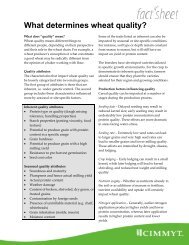

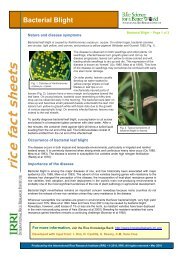

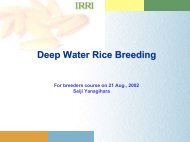
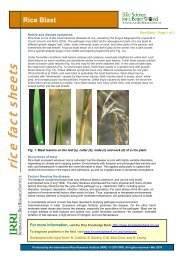
![International Standards' Organization â Rice Specification [ISO 7301]](https://img.yumpu.com/36696862/1/190x245/international-standards-organization-a-rice-specification-iso-7301.jpg?quality=85)

